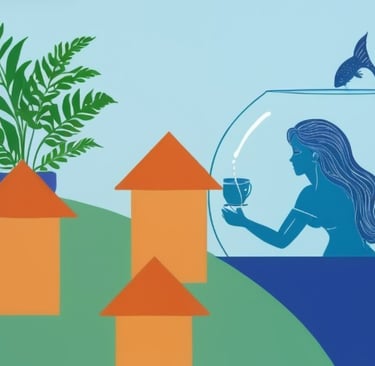Fascinating World of Fishes: Facts, Habitats, and Mythology
2/23/2025


"Celestial Fins: Dreamy fish that look like they swam from the stars"
Interesting Facts About Fishes
Fishes showcase an astonishing variety of forms and adaptations that exemplify the incredible diversity present in the aquatic realm. With over 33,000 recognized species, they inhabit every conceivable water environment, from the deepest abyssal zones of the ocean to the shallowest freshwater lakes. Among these species are some remarkably unusual examples, such as the immortal jellyfish (Turritopsis dohrnii), which has the unique ability to revert to its juvenile form after reaching maturity, potentially allowing it to bypass death entirely.
Another fascinating aspect of fishes is their incredible range of sizes. The smallest fish, the Paedocypris progenetica, can be as tiny as 7.9 mm in length, while the largest, the whale shark (Rhincodon typus), can reach lengths of up to 18 meters or more. This vast size disparity reflects the adaptability of fishes to various ecological niches and their ability to thrive under diverse conditions.
Interestingly, many fish species exhibit extraordinary reproductive behaviors. Some, such as the clownfish, engage in complex social structures, where dominant individuals control breeding, while others practice mouthbrooding, where parents carry eggs or young in their mouths for protection. Moreover, certain species undertake impressive migratory journeys, such as the Pacific salmon, which travel thousands of kilometers back to spawn in freshwater streams where they were born, showcasing their remarkable homing abilities.
Moreover, fishes have evolved unique adaptations that enhance their survival. For instance, many species possess the ability to camouflage, allowing them to blend seamlessly into their surroundings to evade predators. Others exhibit bioluminescence, emitting light to attract mates or lure prey. These captivating traits and behaviors illustrate the extraordinary capabilities possessed by fishes, inviting further exploration into the remarkable field of ichthyology.
Nature of Fishes
Fishes represent a diverse group of aquatic vertebrates that play a crucial role in the world's ecosystems. Their biological characteristics are distinct, setting them apart from other animal species. Primarily, fishes are characterized by their streamlined bodies, which are adapted for efficient locomotion through water. They possess gills for breathing, which allow them to extract oxygen from the water. This anatomical feature differentiates them from terrestrial animals that rely on lungs for respiration.
The skeletal structure of fish is predominantly composed of cartilage or bone, which provides support and structure while remaining lightweight to facilitate swimming. This structural adaptation is vital for survival in various aquatic environments. Fishes exhibit remarkable reproductive strategies; some species lay thousands of eggs, while others engage in live births or utilize parental care to enhance the survival rates of their young. Breeding behaviors vary significantly across species, influenced by environmental factors such as water temperature, seasonality, and availability of food sources.
Moreover, fishes display a range of behavioral patterns that reflect their ecological roles. For instance, schooling behavior is prevalent among many species, providing protection against predators and enhancing foraging efficiency. In freshwater and saltwater habitats alike, fishes serve as both predators and prey, contributing to the intricate balance of food webs. Herbivorous species help control algae growth, while carnivorous fishes maintain populations of smaller fish and invertebrates. Through their feeding habits, fishes play a pivotal role in nutrient cycling within aquatic ecosystems, supporting the health and sustainability of their environments.
Understanding the nature and biology of fishes not only emphasizes their unique adaptations and reproductive strategies but also showcases their ecological significance. This appreciation is essential for promoting conservation efforts and safeguarding the rich diversity of fish species and their habitats around the globe.
Fish Habitats in India
India, with its vast geographical expanse, offers a remarkable diversity of fish habitats, ranging from freshwater rivers and lakes to coastal and marine environments. The country's intricate network of rivers, including the Ganges, Brahmaputra, and Godavari, serves as essential habitats for various fish species. Freshwater ecosystems like these are home to endemic species such as the Indian Mahseer and the Hilsa, each thriving in unique water conditions characterized by varying flow rates and ecological parameters.
In addition to rivers, numerous lakes and ponds scattered across the subcontinent provide habitats for many freshwater fishes. Each lake, such as the famous Dal Lake or Loktak Lake, harbors distinct fish communities influenced by factors such as water temperature, oxygen levels, and the presence of aquatic vegetation. These environments support a range of fish, including common carp and tilapia, and serve as crucial breeding grounds, making them vital ecosystems for fish conservation.
Coastal regions and marine habitats are equally significant in India, stretching along the coastline from the Arabian Sea to the Bay of Bengal. These marine environments support a plethora of species, including popular commercial fishes like pomfret and tuna, as well as various shellfish and crustaceans. The health of these marine ecosystems is influenced by factors like salinity, ocean currents, and anthropogenic activities. Overfishing and habitat degradation pose threats to fish populations, prompting the need for conservation measures.
Conservation efforts are essential to protect these ecologically rich areas. Various initiatives, including the creation of marine protected areas and efforts to restore freshwater habitats, aim to ensure sustainable fish populations. The cultural significance of these fish habitats is notable as well, as local communities depend on them for livelihood, food security, and traditional practices, underpinning the socio-economic fabric linked to India's rich aquatic biodiversity.
Astrology and Mythology Connection of Fishes
Fishes have long been a source of intrigue and inspiration across various cultures, particularly within astrology and mythology. In astrological terms, the zodiac sign Pisces, represented by two fish swimming in opposite directions, encapsulates themes of duality, intuition, and emotional depth. People born under this sign are often believed to possess heightened empathetic abilities, allowing them to connect deeply with others and foster an understanding of their emotional landscapes. The fish symbolizes creativity, sensitivity, and fluidity, which resonate within the Piscean ethos.
Examining mythology reveals a plethora of stories that highlight the significance of fishes. In ancient Babylonian mythology, the fish-god Oannes emerged from the sea to impart knowledge to humankind, effectively bridging the gap between the divine and the mortal realms. Similarly, in Greek mythology, the constellation Pisces was said to represent the story of Aphrodite and Eros, who transformed into fishes to escape the monstrous Typhon. Such narratives underscore the reverence for the aquatic world and echo the traits associated with Pisces, such as adaptability and a nurturing spirit.
Cultures around the world often view fishes not merely as creatures of the water but as embodiments of spiritual lessons and connections to the divine. In Hindu mythology, the fish is linked to the deity Vishnu, who took the form of a fish to save humanity from a great deluge. This illustrates the fish's prominent position in representing salvation and hope, further enriching the symbolic landscape surrounding these aquatic beings. Through these varied cultural lenses, it becomes clear that fishes play a vital role in articulating human experiences and emotions, bridging rare narratives with the complexities of existence.


Contacts
Socials
Subscribe to our newsletter
support@otgscience.in
Copyright © 2024 otgscience.in
.
